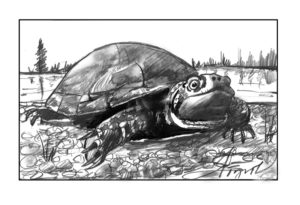By Susan Shea
As spring warms the water, a turtle, covered by leaves and mud at the bottom of a wetland where she hibernated for the winter, awakens. Emerging from the water, she basks on shore. The sun illuminates her bright yellow throat and her high, domed shell, or carapace, dark and shiny with light flecks. The underside of her shell, or plastron, is yellow with black patches around the edges. The plastron is hinged, so the turtle can retreat inside and partially close her shell. At 7 to 9 inches long, she is much larger than the familiar painted turtle. This is a Blanding’s turtle, named for the early Pennsylvania physician and naturalist, William Blanding, who first described the species in the early 1800s.
Rather secretive and seldom seen in the Northeast, Blanding’s turtles live in southernmost Maine, southeastern New Hampshire, and eastern Massachusetts. Small, isolated populations occur in New York and Pennsylvania. The Blanding’s turtle is listed as threatened or endangered in all of these northeastern states. These semi-aquatic turtles also inhabit the Great Lakes States and Upper Midwest where they have also become rare.

Leaving the wetland where she hibernated, the turtle trudges through the woods to a nearby vernal pool where frogs and salamanders breed. Here, she spends weeks gorging on masses of amphibian eggs and tadpoles, satisfying most of her food requirements for the year. She also encounters other turtles of her kind, including males, and mates. Our turtle is 14 years old, and has just reached sexual maturity.
Eventually, the female turtle leaves the vernal pool and travels a mile over land and via streams to a marsh where she has found frogs, snails, crawfish, and dragonfly nymphs to eat in past summers. She’s an agile swimmer and able to catch fish, too. In late June, she leaves the marsh to search for well-drained, sandy soil in a sunny location in which to lay her eggs.
For thousands of years, Blanding’s turtles have travelled between wetlands over the course of their annual lifecycles. Today, their habitat has been damaged and fragmented by development and roads, and fast-moving vehicles pose a grave danger to turtles. Fortunately, our turtle makes it safely across the road this year. If she is not hit by a car, she may live to be more than 75 years old. Blanding’s turtles have evolved a long lifespan to compensate for a late age of sexual maturity and relatively low fertility. The loss of even one female turtle can seriously impact the population.
The turtle digs a deep hole and deposits nine leathery eggs. Then she covers the hole and moves on to another wetland. If the eggs are not eaten by a skunk, raccoon, or other predator, the young will hatch two to four months later, depending on soil temperature. Vulnerable to predators and moving vehicles, they will head towards the nearest wetland.
By late summer, food supplies have diminished, and the female turtle becomes dormant under leaf litter in the woods for a few weeks. With the coming of fall rains, she’ll return to a pond or shrub swamp to hibernate.
Concerned about their decline, wildlife agencies and others in the states where these turtles occur formed the Northeast Blanding’s Turtle Working Group in 2004 to assess populations and develop conservation plans. Since that time, several measures to protect turtles have been implemented. In New Hampshire, nest sites were created in an area of high turtle density by clearing openings in the forest near wetlands and hauling in sand to encourage turtles to nest there, rather than cross the road.
Many roads near wetlands now sport seasonal turtle crossing signs. In Massachusetts, wide tunnels with natural bottoms have been installed beneath roads that were hot spots for turtle mortality, accompanied by fencing to guide Blanding’s and other rare turtles towards the passages. In southern Maine, a shelf with a natural substrate was created below an interstate highway bridge and a tunnel was recently installed under another busy road that bisects wetlands used by Blanding’s turtles. Because they use both wetlands and upland forests, Blanding’s turtles do best in large, undeveloped forest blocks with wetland complexes, and the permanent conservation of these areas is a high priority.
With conservation action, hopefully these unique turtles will continue to find a home in the Northeast.
Susan Shea is a naturalist, writer, and conservationist based in Vermont. Illustration by Adelaide Murphy Tyrol. The Outside Story is assigned and edited by Northern Woodlands magazine and sponsored by the Wellborn Ecology Fund of the New Hampshire Charitable Foundation: nhcf.org. This piece received additional support from the Arthur Getz Trust, Citizens Bank, N.A.




